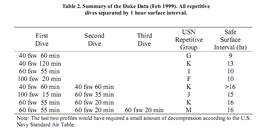Posted again as the original seems to have gotten lost in the discussion.
As a Scuub Nuub with a recent PADI AOW cert, I find myself pondering this;
When I use my Computer as the yardstick for my bottom times, it gives me credit for an ascending profile, this technically violates my NDL Table limits. The reason that this is OK, is because my Comp is using a safe algorithm .... yes?
By the same logic, is it acceptable to follow the "No Fly" recommendation of my comp after single or multiple dives, even if they are lower than the DAN and/or PADI recommendations?
Best Regards
Richard (Riger)
As a Scuub Nuub with a recent PADI AOW cert, I find myself pondering this;
When I use my Computer as the yardstick for my bottom times, it gives me credit for an ascending profile, this technically violates my NDL Table limits. The reason that this is OK, is because my Comp is using a safe algorithm .... yes?
By the same logic, is it acceptable to follow the "No Fly" recommendation of my comp after single or multiple dives, even if they are lower than the DAN and/or PADI recommendations?
Best Regards
Richard (Riger)





